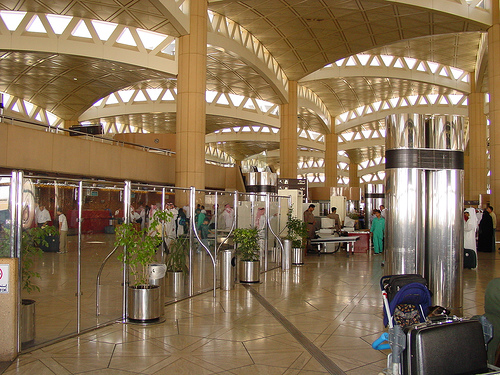The question is not really what you can bring, it's what you can't! The rules are very clear and simple...
Customs Regulations
A number of items are not allowed to be brought into the Kingdom due to local regulations. These includealcoholic beverages, pork and pork products, prohibited drugs and narcotics, firearms, explosives, edged weapons and pornographic materials.
For more information please refer to the following link: www.customs.gov.sa
Restrictions
Certain items are forbidden in the Kingdom including alcohol, narcotics, weapons, ammunition, pork and pornography. Prescription drugs must be documented.
Bring your Pets
Bringing pet to Saudi Arabia requires an official health certificate and examination by the quarantine office.
Birds of All Kinds require a permit form National Commission for Wildlife Conservation and Development.
Medicines and Herbal Medical
Medicines of all kinds shall not be released unless after being presented the Ministry of Health’s representative.
Bringing your Car/Vehicle
• The vehicle shall be in conformity with the Kingdom's standards, and its steering system shall not undergo modification.
• There are no damages on the vehicle body. If the damage occurs at the arrival port, a certificate from the competent authorities is required to be submitted accordingly.
• The vehicles that have been subject to accidents such as drowning, fire, collision, rollover, etc are not allowed to be imported.
• The vehicles used as taxicab or by police are not allowed to be imported.
• The importer's residence authorization (Iqama) shall be valid, if the importer is not a citizen of any of the GCC states.
• It shall not be permissible to import more than one vehicle per year, if the importer does not have a commercial registration legalizing business activity in vehicle sale and import.
Documents required for assessment of vehicle customs duty First: Vehicles imported from the GCC States:
1. Export form issued by the competent agency (Traffic Department) in the country where the vehicle registered, or a quittance document along with a valid vehicle ownership document issued by the competent authorities in the exporting country of the vehicle, if it is secondhand.
2. Customs declaration of the customs administration in the country of exportation. 3. If the vehicle is not in the name of the importer, it is required to submit a legal power of attorney issued not more than one year ago that gives the agent the right to dispose of the vehicle and finalize payment of customs duty due on it.
4. For clearance purposes among the GCC States: a) If the vehicle is imported through any of the GCC states' ports after January 1, 2003 and its final destination is Saudi Arabia, the following document shall be submitted: -
The original copy of the import declaration of the first entry port in the exporting country or a legalized copy of it sealed with the clearance seal of the exporting country including all required information and the amount of the customs duty subject to the clearance.
B) If the vehicle is imported to any of the GCC states after January 1, 2003 and the importer bought it from any of the GCC states' markets and he wants to transport it to the Kingdom, the following documents shall be submitted:
1. The original copy of the statistical customs declaration sealed with the clearance seal of the exporting country including all required information and the amount of the customs duty subject to the clearance.
2. The original copy of the import declaration of the first entry port in the exporting country or an attested copy of it. Second:
Vehicles imported from other countries:
1. Submit a legal document indicating the importer's ownership of the vehicle. This document shall be attested by the Saudi commercial attaché or his duly authorized representative in the country where the vehicle purchased, or by the chamber of commerce in the exporting country.
2. Export declaration of the customs administration in the country from which the vehicle exported. The invoice and the certificate of origin shall be attached to the export declaration.
3. A document issued by the competent security authorities in the shipping country indicating that the vehicle is not wanted. Secondhand vehicle appraisal mechanism:
1. The value for customs purposes is calculated according to the price lists issued by the manufacturers. Vehicles manufactured for special purposes and antique cars are excluded.
2. The depreciation rate is deducted according to the model year, and the value of freight and insurance is added.
3. The method of deduction is on monthly basis according to the age of the vehicle. 4. The importation date shall be taken into account to determine the age of the vehicle in years and months. The model year starts at the beginning of January and expires at the end of December.
5. The vehicle imported during the first six months of the model year is considered new and there is no deduction.
6. For the vehicle imported during the last six months of the model year there will be a deduction at a rate of 2% per month or parts of it.
7. For the vehicle imported during the second year until the fifth year of the model year there will be a deduction at a rate of 1% per month or parts of it.
8. The maximum deduction rate is 60% of the price of the vehicle imported after more than five years from the beginning of the model year.
9. The customs duty rate is (5% for motor cars, 12% for trucks).




No comments:
Post a Comment